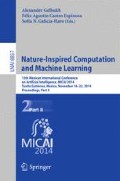Abstract
Recently the parametric representation using cochlea behavior has been used in different studies related with Automatic Speech Recognition (ASR). That is because this hearing organ in mammalians is the most important element used to make a transduction of the sound pressure that is received by the outer ear. This paper shows how the macro and micro mechanical model is used in ASR tasks. The values that Neely, Elliot and Ku founded in their works, related with the macro and micro mechanical model such as Neely were used to set the central frequencies of a bank filter to obtain parameters from the speech in a similar form as MFCC (Mel Frequency Cepstrum Coefficients) has been constructed.
An approach that considers a new form to distribute the bank filter in our parametric representation is proposed. Then this distribution of the bank filter to have a different representation of the speech in frequency domain compared with MFCC is applied. The response of these three values mentioned above into macro and micro mechanical model to create the central frequencies of the bank filter were used, then the Mel scale function substituted by a representation based in the cochlear response based on the Neely model. This model was used with a set of different parameters of the cochlea, used by Nelly, Elliot and Ku in their works, such as mass, damping and stiffness; among others. A performance of 98 to 100% was reached for a task that uses Spanish isolated digits pronounced by 5 different speakers. Corpus SUSAS with neutral sound records with some advantages in comparison with MFCC was applied.
Access this chapter
Tax calculation will be finalised at checkout
Purchases are for personal use only
Preview
Unable to display preview. Download preview PDF.
References
Noll, A.M.: Shortime Spectrum and Cepstrum Techniques for Vocal Pitch Detection. Journal of Acoustical Society of America 36, 296–302 (1964)
John, M.: Linear Prediction: A Tutorial Review. Proceedings of the IEEE 63(4), 561–580 (1975)
Davis, S.B., Mermelstein, P.: Comparison of Parametric Representations for Monosyllabic Word Recognition in Continuously Spoken Sentence. IEEE Transactions on Acoustics, Speech and Signal Processing ASSP-28(4) (August 1980)
Hermansky: Perceptual Linear Predictive (PLP) analysis of speech. Journal of Acoustical Society of America, 1738–1752 (April 1990)
Dallos, P., Fay, R.R.: Mechanics of the cochlea: modeling effects. In: de Boer, S.E. (ed.) The Cochlea. Springer, USA (1996)
Luis, R., Ruggero, M.A.: Mechanics of the Mammalian Cochlea’. Physiological Reviews 81(3) (July 2001)
Kim, D.S., Lee, S.Y., Kill, R.M.: Auditory processing of speech signals for robust speech recognition in real word noisy environments. IEEE Trans. Speech Audio Processing 7(1), 55–69 (1999)
Geisler, C.D.: A model of the effect of outer hair cell motility on cochlear vibration. Hear. Res. 24, 125–131 (1996)
Geisler, C.D., Shan, X.: A model for cochlear vibration based on feedback from motile outer hair cells. In: Dallos, P., Geilser, C.D., Matthews, J.W., Ruggero, M.A., Steele, C.R. (eds.) The Mechanics and Biophysics of Hearing, pp. 86–95. Springer, New York (1990)
Holmberg, M., Gelbart, D., Hemmert, W.: Automatic speech recognition with an adaptation model motivated by auditory processing. IEEE Trans. Audio, Speech, Language Processing 14(1), 44–49 (2006)
Haque, S., Togneri, R.: A feature extraction method for automatic speech recognition based on the cochlear nucleus. In: 11th Annual Conference of the International Speech Communication Association, InterSpeech 2010, Makuhari, Chiba, Japan, September 26-30 (2010)
Harczos, T., Szepannek, G., Klefenz, F.: Towards Automatic Speech Recognition based on Cochlear Traveling Wave Delay Trajectories. In: Dau, T., Buchholz, J.M., Harte, J.M., Christiansen, T.U. (eds.) 1st International Symposium on Auditory and Audiological Research (ISAAR 2007), Auditory Signal Processing in Hearing-impaired Listeners (2007) ISBN: 87-990013-1-4. Print: Centertryk A/S
Keener, Sneyd, J.: Mathematical Physiology. Springer, USA (2008)
Elliot, S.J., Ku, E.M., Lineton, B.A.: A state space model for cochlear mechanics. Journal of Acoustical Society of America 122, 2759–2771 (2007)
Elliott, S.J., Lineton, B., Ni, G.: Fluid coupling in a discrete model of cochlear mechanics. Journal of Acoustical Society of America 130, 1441–1451 (2011)
Ku, E.M., Elliot, S.J., Lineton, B.A.: Statistics of instabilities in a state space model of the human cochlea. Journal of Acoustical Society of America 124, 1068–1079 (2008)
Neely, S.T.: A model for active elements in cochlear biomechanics. Journal of Acoustical Society of America 79, 1472–1480 (1986)
Békésy: Concerning the pleasures of observing, and the mechanics of the inner ear. Nobel Lecture (December 11, 1961)
Mario, J.H., Rodríguez, J.L.O., Guerra, S.S., Fernández, R.B.: Computational Model of the Cochlea using Resonance Analysis. Journal Revista Mexicana Ingeniería Biomédica 33(2), 77–86 (2012)
Mario, J.H.: Modelo mecánico acústico del oído interno en reconocimiento de voz, Ph. D. Thesis, Center for Computing Research-IPN (Junio 2013)
Author information
Authors and Affiliations
Editor information
Editors and Affiliations
Rights and permissions
Copyright information
© 2014 Springer International Publishing Switzerland
About this paper
Cite this paper
Oropeza Rodríguez, J.L., Suárez Guerra, S. (2014). Using Values of the Human Cochlea in the Macro and Micro Mechanical Model for Automatic Speech Recognition. In: Gelbukh, A., Espinoza, F.C., Galicia-Haro, S.N. (eds) Nature-Inspired Computation and Machine Learning. MICAI 2014. Lecture Notes in Computer Science(), vol 8857. Springer, Cham. https://doi.org/10.1007/978-3-319-13650-9_22
Download citation
DOI: https://doi.org/10.1007/978-3-319-13650-9_22
Publisher Name: Springer, Cham
Print ISBN: 978-3-319-13649-3
Online ISBN: 978-3-319-13650-9
eBook Packages: Computer ScienceComputer Science (R0)

